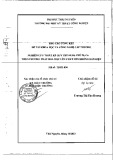
BioMed Central
Page 1 of 9
(page number not for citation purposes)
Virology Journal
Open Access
Methodology
A simplified in vitro ligation approach to clone an E1B55k-deleted
double-targeted conditionally-replicative adenovirus
Yosef S Haviv
Address: Department of Medicine, Hadassah-Hebrew University Medical Center, Jerusalem, 91120, Israel
Email: Yosef S Haviv - yhaviv@hadassah.org.il
Abstract
Background: Construction of conditionally-replicative Adenovirus (CRAd) is complex and time-
consuming. While homologous recombination (HR) using a two-plasmid system in bacteria is
commonly used to generate CRAds, alternative methods may be required when HR fails.
Previously, in vitro ligation has been suggested to facilitate construction of E1/E3-deleted,
replication-incompetent Ad vectors. However, in vitro ligation has only rarely been used to
generate CRAds and may be a complex procedure for molecular biologists who are not experts in
the field.
Methods and Results: A modified in vitro ligation approach was developed to construct a double-
targeted, E1B55k-deleted CRAd. The method allowed the incorporation of a tumor-specific
promoter, e.g. the heat-shock protein 70 (hsp70) promoter, upstream of E1a, deletion of the
E1B55k gene, and HR-free cloning of the recombined E1 55k gene into the Ad genome. The genetic
structure of the CRAd was confirmed using restriction analysis and PCR. The replication rate of
the hsp70E1Δ55k CRAd was 1.5–2% of Ad without E1Δ55k deletion.
Conclusion: A 3-step cloning approach can generate a double-targeted, E1B55k-deleted CRAd
using a straight-forward, modified in vitro ligation procedure.
Introduction
Adenoviruses (Ad) are excellent gene transfer vectors and
are extensively used for high-level transgene expression in
vitro and in vivo. One of the attributes rendering Ad vectors
particularly well suited for this purpose is the capacity to
manipulate their genome. Typically, Ad vectors are con-
verted into mammalian gene transfer vectors by replacing
the E1 gene with the foreign gee of interest. E1 deletion
serves two goals, i.e. to increase the cloning capacity to 5
kb (and to 8 kb if the E3 region is also deleted) and to
render Ad vectors replication-incompetent.
Two approaches to have been traditionally used to con-
struct recombinant Ad vectors. First, homologous recom-
bination (HR) in either packaging cell lines, bacteria or
yeast. Second, in vitro ligation using standard molecular
biology procedures. These two methods rely on the fact
that purified, linear Ad DNA is infectious, resulting in
recombinant Ad virions after transfection into packaging
cell lines. In vitro ligation was the first approach to manip-
ulate the Ad genome. However, it was abandoned for
many years because the large, 35.9 kb Ad genome that
encodes more than 50 gene products, generally lacks suf-
ficient unique restriction sites. To overcome this limita-
tion HR was developed, initially using ClaI digested viral
DNA. Next, the viral DNA was transfected into the pack-
aging cell line to undergo spontaneous, albeit inefficient
HR. To enhance HR efficiency in mammalian cells, a two-
Published: 7 February 2009
Virology Journal 2009, 6:18 doi:10.1186/1743-422X-6-18
Received: 26 January 2009
Accepted: 7 February 2009
This article is available from: http://www.virologyj.com/content/6/1/18
© 2009 Haviv; licensee BioMed Central Ltd.
This is an Open Access article distributed under the terms of the Creative Commons Attribution License (http://creativecommons.org/licenses/by/2.0),
which permits unrestricted use, distribution, and reproduction in any medium, provided the original work is properly cited.






























